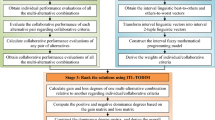Abstract
This study aims to decide the location of emergency medical centers and the evacuation of survivors after a disaster happened. An extended interactive multi-criteria decision making method (TODIM) with interval 2-tuple linguistic variables is proposed to evaluate the potential locations of the emergency medical centers. A bi-objective mixed-integer programming is then established to determine the final locations and the evacuation plan based on previous evaluations. A real case of an earthquake in Wenchuan, China in 2008 is analyzed to demonstrate the effectiveness of our method.


Similar content being viewed by others
Notes
https://www.baidu.com/sf_bk/item/5.12
 /11042644?fr=kg_general&ms=1&rid=11341392210854333362.
/11042644?fr=kg_general&ms=1&rid=11341392210854333362.
References
Boostani A, Jolai F, Bozorgi-Amiri A (2018) Optimal location selection of temporary accommodation sites in Iran via a hybrid fuzzy multiple-criteria decision making approach. J Urban Plan Dev 144(4):04018039
Chang MS, Tseng YL, Chen JW (2007) A scenario planning approach for the flood emergency logistics preparation problem under uncertainty. Transp Res Part E Logisti Transp Rev 43(6):754
Chen X, Fan ZP, Li ZW, Han LX, Zhang X, Jia HC (2015) A two-stage method for member selection of emergency medical service. J Comb Optim 30(4):871C891
Chen CT, Tai WS (2005) Measuring the intellectual capital performance based on 2-tuple fuzzy linguistic information. In: The 10th annual meeting of APDSI, Asia Pacific region of decision sciences institute, Vol 20
Chen ZZ (2006) A multi-objective decision model of emergency rescue facility location for large-scale emergency incidents. Manag Sci China 19(4):10–14
Chen X, Zhao L, Liang HM, Lai KK (2019) Matching patients and healthcare service providers: a novel two-stage method based on knowledge rules and OWA-NSGA-II algorithm. J Comb Optim 37(1):95–113
Cheng YK, Mei LL (2018) A survey on approximation mechanism design without money for facility location games. Oper Res Trans 22(2):93–104
Dekle J, Lavieri MS, Martin E, Emir-Farinas H, Francis RL (2005) A florida county locates disaster recovery centers. Interfaces 35(2):133–139
Drakaki M, Goren HG, Tzionas P (2018) An intelligent multi-agent based decision support system for refugee settlement siting. Int J Disaster Risk Reduct 31:576–588
Gai L, Ji JD (2019) An integrated method to solve the healthcare facility layout problem under area constraints. J Comb Optim 37(1):95–113
Gomes LFAM, Lima MMPP (1992) TODIM: basic and application to multicriteria ranking of projects with environmental impacts. Found Comput Decis Sci 16(4):113–127
Kahneman D, Tversky A (1979) Prospect theory: an analysis of decision under risk. Econom J Econom Soc 47(2):263–291
Huang R, Kim S, Menezes MBC (2010) Facility location for large-scale emergencies. Ann Oper Res 181(1):271–286
Herrera F, Martinez L (2000) A 2-tuple fuzzy linguistic representation model for computing with words. IEEE Trans Fuzzy Syst 8(6):746–752
Junian J, abd Azizifar V (2018) The evaluation of temporary shelter areas locations using geographic information system and analytic hierarchy process. Civ Eng J 4(7):1678–1688
Kilci F, Kara BY, Bozkaya B (2015) Locating temporary shelter areas after an earthquake: a case for Turkey. Eur J Oper Res 243(1):323–332
Liu HC, Lin QL, Wu J (2014) Dependent interval 2-tuple linguistic aggregation operators and their application to multiple attribute group decision making. Int J Uncertain Fuzziness Knowl Based Syst 22(05):717–735
Paul JA, Batta R (2008) Models for hospital location and capacity allocation for an area prone to natural disasters. Int J Oper Res 3(5):473
Rosas JHA, Gao H, Alidaee B, Teng WY (2009) Allocation of emergency and recovery centres in Hidalgo, Mexico. Int J Serv Sci 2(2):206
Trivedi A (2018) A multi-criteria decision approach based on DEMATEL to assess determinants of shelter site selection in disaster response. Int J Disaster Risk Reduc 31:722–728
Trivedi A, Singh A (2017a) Prioritizing emergency shelter areas using hybrid multi-criteria decision approach: a case study. J Multi-Criteria Decis Anal 24(3–4):133–145
Trivedi A, Singh A (2017b) A hybrid multi-objective decision model for emergency shelter location-relocation projects using fuzzy analytic hierarchy process and goal programming approach. Int J Proj Manag 35(5):827–840
Wang BC, Li M, Hu Y, Huang L, Lin SM (2018) Optimizing locations and scales of emergency warehouses based on damage scenarios. J Oper Res Soc China. https://doi.org/10.1007/s40305-018-0215-5
Wang L, Hu YP, Liu HC, Shi H (2019) A linguistic risk prioritization approach for failure mode and effects analysis: a case study of medical product development. Qual Reliab Eng Int 35(6):1735–1752
Zou K, Liu GJ, Li YP, Du L, He J (2008) Risk factors for death and injuries in earthquakes: a systematic review. Chin Evid Based Med Mag 8(7):477–482
Zhang H (2012) The multiattribute group decision making method based on aggregation operators with interval-valued 2-tuple linguistic information. Math Comput Model 56(1–2):27–35
Zhang H (2013) Some interval-valued 2-tuple linguistic aggregation operators and application in multiattribute group decision making. Appl Math Model 37(6):4269–4282
Zhu JM, Liu SY, Ghosh S (2019) Model and algorithm of routes planning for emergency relief distribution in disaster management with disaster information update. J Comb Optim 38:208–223
Author information
Authors and Affiliations
Corresponding author
Additional information
Publisher's Note
Springer Nature remains neutral with regard to jurisdictional claims in published maps and institutional affiliations.
Research supported by NSFC (11201333).
Appendix
Appendix
See Tables 9, 10, 11, 12, 13, 14, 15, 16, 17, 18, 19, 20, 21, 22, 23, 24, 25, 26, 27, 28, 29, 30, 31, 32.
Rights and permissions
About this article
Cite this article
Gai, L., Peng, Z., Zhang, J. et al. Emergency medical center location problem with people evacuation solved by extended TODIM and objective programming. J Comb Optim 42, 1004–1029 (2021). https://doi.org/10.1007/s10878-019-00502-1
Published:
Issue Date:
DOI: https://doi.org/10.1007/s10878-019-00502-1





 /11042644?fr=kg_general&ms=1&rid=11341392210854333362.
/11042644?fr=kg_general&ms=1&rid=11341392210854333362.